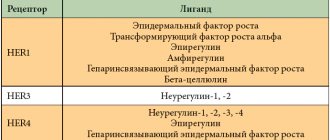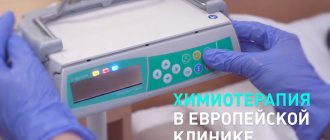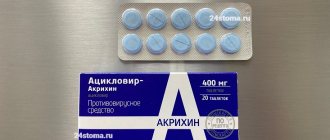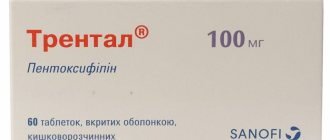Pharmacological properties of the drug Dobutamine
Synthetic catecholamine with a pronounced cardiotonic effect. Dobutamine consists of 2 stereoisomers; pharmacological properties are due to the different chemical affinities of its (+)- and (-)-enantiomers to α- and β-adrenergic receptors. (-)-Dobutamine is an agonist of α1-adrenergic receptors, (+)-dobutamine exhibits antagonistic activity towards them. Both enantiomers are full β-adrenergic receptor agonists, with (+)-dobutamine having 10 times more pronounced activity. Dobutamine is selective for the β1-subtype of receptors, which determines its pronounced cardiotonic effect: it increases stroke volume, IOC, myocardial oxygen consumption, and increases blood pressure. Dobutamine has positive dromo- and chronotropic effects only when used in high doses. The effect occurs 1–2 minutes after the start of intravenous administration. The maximum effect is usually achieved after 10 minutes. The half-life of dobutamine averages 2 minutes because it is rapidly metabolized by catechol-O-methyltransferase and glucuronidated. Excreted mainly in urine.
Dobutamine Hexal Liof d/prig solution d/inf 250mg
The drug Dobutamine Hexal is intended only for intravenous infusion after preliminary dilution. The rate and duration of administration of the drug Dobutamine Hexal is determined individually, taking into account the patient’s response and the dynamics of hemodynamic parameters.
The drug Dobutamine Hexal, lyophilisate for the preparation of solution for infusion,
initially diluted in 10 ml of sterile water for injection, if the drug is not completely dissolved, add another 10 ml.
If further dilution of the concentrate
the drug Dobutamine Hexal, you should use a 5% dextrose (glucose) solution, 0.9% sodium chloride solution, Ringer's solution or sodium lactate solution.
The prepared solutions are not intended for repeated sampling of the drug. Due to the short half-life of Dobutamine Hexal, continuous long-term infusions should be administered.
The duration of intravenous infusion depends on clinical efficacy results. While using the drug Dobutamine Hexal, constant monitoring of heart rate, heart rate, blood pressure, diuresis volume and infusion rate is necessary. If possible, cardiac output, central venous pressure, and pulmonary capillary pressure should also be monitored during treatment.
For adults,
in the absence of other prescriptions, Dobutamine Hexal is recommended to be administered in doses of 2.5–10 mcg per 1 kg of body weight per minute. In some cases, the dose is up to 40 mcg/kg/min.
For children
It is recommended to use Dobutamine Hexal in doses of 2 to 20 mcg per 1 kg of body weight per 1 min. When doses greater than or equal to 7.5 mcg per 1 kg of body weight per minute are used, most side effects (especially tachycardia) begin to appear. There is evidence that the minimum effective dose in childhood is higher than in adults and is 0.5–1 mcg/kg/min. At the same time, the maximum tolerated dose in children is lower than in adults. Achieving the required doses in children should be done with caution due to the presence of apparently lower therapeutic latitude in childhood!
Recommendations for infusions of the drug Dobutamine Hexal
| Dose recommendations for intermittent infusion* | ||||
| 1 injection bottle of 250 mg of dobutamine in 50 ml of solvent | ||||
| Dose areas | Body mass | |||
| 50 kg | 70 kg | 90 kg | ||
| Low: 2.5 mcg/kg/min | ml/hour (ml/min) | 1,5 (0,025) | 2,1 (0,035) | 2,7 (0,045) |
| Average: 5 mcg/kg/min | ml/hour (ml/min) | 3,0 (0,05) | 4,2 (0,07) | 5,4 (0,09) |
| High: 10 mcg/kg/min | ml/hour(ml/min) | 6,0 (0,10) | 8,4 (0,14) | 10,8 (0,18) |
| * At double concentration, i.e. at 2 × 250 mg of dobutamine in 50 ml of solvent, the recommended doses must be reduced by 2 times. | ||||
| Dose recommendations for continuous infusion* | ||||
| 1 injection bottle of 250 mg of dobutamine in 500 ml of solvent | ||||
| Dose areas | Body mass | |||
| 50 kg | 70 kg | 90 kg | ||
| Low: 2.5 mcg/kg/min | ml/hour (drops/min) | 15 (5) | 21 (7) | 27 (9) |
| Average 5 mcg/kg/min | ml/hour (drops/min) | 30 (10) | 42 (14) | 54 (18) |
| High: 10 mcg/kg/min | ml/hour (drops/min) | 60 (20) | 84 (28) | 108 (36) |
| * At double concentration, i.e. at 2 × 250 mg of dobutamine in 500 ml of solvent, the recommended doses must be reduced by 2 times. | ||||
Before discontinuing the drug, it is necessary to gradually reduce its dose!
Carrying out a stress echocardiography test with dobutamine
carried out by gradually increasing the dose of the drug. Control over the method and duration of drug administration is necessary.
The most commonly used protocol for conducting a stress echocardiography test with dobutamine
The most commonly used protocol for conducting a “stress echocardiography” test with dobutamine to determine “vitality” and myocardial ischemia:
The initial infusion dose of dobutamine 5 mcg/kg/min is increased every 3 minutes to 10, 20, 30, 40 mcg/kg/min until the result is achieved.
If at 3 minutes of administration of the maximum dose it is not possible to achieve the test termination criteria, then additionally (to increase the heart rate) 0.25 mg of atropine sulfate is administered intravenously 4 times with an interval of 1 minute against the background of a continuing infusion of dobutamine at a dose of 40 mcg/kg /min. Alternative dosing regimens
differ in the administration of the maximum dose of Dobutamine Hexal (up to 50 mcg/kg/min), the maximum dose of atropine (up to 2 mg) and the time of administration of atropine.
To reverse the effects of dobutamine
infusion solutions of beta-blockers are used.
Criteria for stopping the “stress echocardiography” test with dobutamine:
— achieving the maximum heart rate for a given age/sex, calculated by the formula {(220 – age) × 0.85};
- decrease in systolic blood pressure by more than 20 mm Hg. Art. compared to the original;
- progressive increase in blood pressure (for example, systolic more than 220 mm Hg, diastolic - more than 120 mm Hg);
- increasing symptoms of angina pectoris (chest pain, shortness of breath, dizziness, loss of coordination);
- development of abnormal myocardial repolarization on the ECG (horizontal or downward depression of the ST segment, more than 0.2 mV lasting 80 (60) milliseconds after the J point compared to the baseline; progressive or monophasic elevations of the ST segment above 0.1 mV) in patients without a history of myocardial infarction;
- increasing arrhythmia (for example, bigeminy, group extrasystole);
— increasing conduction disturbance;
- development of adverse events;
— violation of local myocardial contractility of more than 1 segment (16-segment echocardiography model);
- development of a global decrease in contractility (including an increase in the end systolic volume of the left ventricle);
— achieving the maximum dose of drugs used in the “stress echocardiography” test scheme.
A “stress echocardiography” test with dobutamine to detect “vitality” and myocardial ischemia should only be performed by a physician with sufficient experience in conducting such studies and with experience in resuscitation. During the study, continuous monitoring of myocardial contractility using echocardiography, changes in the electrocardiogram, and blood pressure control is necessary. When conducting a stress echocardiography test with dobutamine, medications and resuscitation equipment (for example, a defibrillator, intravenous beta-blockers, nitrates, etc.) and personnel trained in the resuscitation procedure should be in the immediate vicinity of the patient.
Symptoms of angina pectoris or impending tachycardia can be relieved by intravenous administration of short-acting beta-blockers or other antiarrhythmic drugs (class I and III antiarrhythmic drugs should be excluded). It is possible to take nitroglycerin and/or beta-blockers under the tongue.
Use of the drug Dobutamine
Administered only intravenously in diluted form. Before use, dilute with 5% glucose solution, Ringer's solution, sodium chloride or sodium lactate. The initial rate of dobutamine administration is about 2.5 mg/kg body weight per 1 minute; subsequently the speed is gradually increased. The average infusion rate to obtain the optimal therapeutic effect is 10 mcg/kg/min; if necessary, it can be increased to 20 mcg/kg/min. The rate of administration and duration of therapy are determined based on clinical parameters - heart rate, diuresis, IOC.
Dobutamine Hexal, 250 mg, lyophilisate for solution for infusion, 1 pc.
IV in the form of infusions.
Dobutamine Hexal is intended only for intravenous infusion after preliminary dilution. The rate and duration of administration of Dobutamine Hexal is determined individually, taking into account the patient’s response and the dynamics of hemodynamic parameters.
Dobutamine Hexal, a lyophilisate for the preparation of a solution for infusion, is initially diluted in 10 ml of sterile water for injection; if the drug is not completely dissolved, another 10 ml is added.
If further dilution of dobutamine concentrate is necessary, 5% glucose solution, 0.9% sodium chloride solution, Ringer's solution or sodium lactate solution should be used.
The diluted solution can be stored for 24 hours, after which it cannot be used.
Solutions containing dobutamine for infusion may give a pink color, the intensity of which will increase over time (due to its oxidation, but there is no significant loss of activity and no increase in toxicity). The prepared solutions are not intended for repeated sampling of the drug. Due to the short half-life of dobutamine, continuous, long-term infusions should be administered.
The duration of IV infusions depends on the results of clinical effectiveness. During the administration of Dobutamine Hexal, constant monitoring of heart rate, heart rate, blood pressure, amount of urine excreted and infusion rate is required. If possible, cardiac output, central venous pressure, and pulmonary capillary pressure should also be monitored during treatment.
In the absence of other prescriptions, adults are recommended to administer Dobutamine Hexal in doses of 2.5–10 mcg/kg/min. In some cases, the dosage is up to 40 mcg/kg/min of dobutamine.
It is recommended that dobutamine be administered to children in doses ranging from 1 to 15 mcg/kg/min. When doses greater than or equal to 7.5 mcg/kg/min are used, most side effects (especially tachycardia) begin to appear. There is evidence that the minimum effective dose in children is higher than in adults. At the same time, the maximum tolerated dose in children is lower than in adults. Achieving the required dosages in children should be done with caution due to the presence of apparently lower therapeutic latitude in childhood!
Recommendations for Dobutamine Hexal infusions at various initial doses
| Dosage recommendations for intermittent infusion* | |||
| 1 fl. for injection 250 mg of dobutamine in 50 ml of solvent | |||
| Dose areas | Data in ml/h* (ml/min) | ||
| Body weight 50 kg | Body weight 70 kg | Body weight 90 kg | |
| Low (2.5 mcg/kg/min) | 1,5 (0,025) | 2,1 (0,035) | 2,7 (0,045) |
| Medium (5 mcg/kg/min) | 3 (0,05) | 4,2 (0,07) | 5,4 (0,09) |
| High (10 mcg/kg/min) | 6 (0,1) | 8,4 (0,14) | 10,8 (0,18) |
*At double concentration, i.e. at 2 × 250 mg of dobutamine in 50 ml of solvent, the recommended dosage must be reduced by 2 times.
Side effects of the drug Dobutamine
From the cardiovascular system - dose-dependent and disappear after stopping the infusion or reducing the rate of administration; possible tachycardia, increased systolic blood pressure, ventricular extrasystole, ventricular tachycardia and ventricular fibrillation, nausea, headache, anginal attacks, palpitations; nonspecific thoracalgia, shortness of breath, skin itching, rash, fever, chills, eosinophilia and bronchospasm, tremor, petechiae, phlebitis and inflammation of paravenous tissue during extravasation of the solution, skin necrosis (with the infusion of concentrated solutions).
Special instructions for the use of Dobutamine
With prolonged administration of dobutamine (more than 72 hours), it is necessary to take into account the development of addiction to it. After cessation of long-term therapy with dobutamine (more than 7 days), a decrease in IOC and an increase in pressure in the pulmonary capillaries may be observed. During pregnancy, dobutamine is used only according to strict indications and under close medical supervision. Before starting therapy, breastfeeding is stopped. Treatment with dobutamine should only be carried out by an experienced cardiologist with careful monitoring of blood pressure, heart rate, blood flow, pressure in the pulmonary capillaries and ECG monitoring. In patients with hypovolemia, before starting treatment with dobutamine, it is necessary to compensate for the existing deficit of blood volume. In acute myocardial infarction, the use of dobutamine in high concentrations may increase myocardial ischemia due to increased myocardial oxygen demand. If dobutamine is used in a dose that does not cause a significant increase in heart rate, it does not increase cardiac function or the size of the ischemic area. In patients with a history of paroxysmal atrial fibrillation and atrial flutter, digoxin should be administered before dobutamine infusion to prevent arrhythmias. Use with caution in patients with hyperthyroidism and hypertension (arterial hypertension). During treatment with dobutamine, the level of potassium in the blood plasma should be monitored.
Description of the drug DOBUTAMIN SANDOZ
When using dobutamine, as with any adrenergic drug, blood pressure (especially systolic) and heart rate should be monitored, as well as potential cardiac arrhythmias. If they develop, the dose should be reduced or the use of dobutamine should be temporarily discontinued. If possible, wedge pressure and cardiac output should also be monitored.
The use of dobutamine in patients may result in an increased need for insulin. Therefore, in patients with diabetes mellitus, blood glucose levels should be monitored when initiating dobutamine treatment when changing the infusion rate and when stopping the infusion.
Dobutamine may provoke or enhance manifestations of ventricular ectopic activity. In rare cases, ventricular tachycardia or fibrillation may develop, the risk of which increases in patients with existing atrial flutter or fibrillation.
Since dobutamine accelerates AV conduction, the ventricular rate may increase in patients with atrial fibrillation, therefore, in patients with this pathology and frequent ventricular systoles, it is necessary to preliminarily correct this condition.
Inotropes, including dobutamine, do not improve hemodynamics in most patients with mechanical obstruction that prevents both filling and ejection of blood from the ventricles. In patients with a marked decrease in the elasticity of the ventricular wall, it may also be difficult to achieve a noticeable inotropic effect. Similar conditions are characteristic of cardiac tamponade, aortic valve stenosis and idiopathic hypertrophic subaortic stenosis.
Patients who have recently taken beta blockers may experience mild vasoconstriction.
When dobutamine is administered intravenously, heart rate and rhythm, blood pressure, and infusion rate should be carefully monitored. At the beginning of therapy, ECG monitoring is recommended until a stable response is obtained.
The use of dobutamine in hypovolemic shock is not recommended.
When using dobutamine, a situation may occur when, despite adequate volumes of ventricular filling and cardiac output, blood pressure does not increase or gradually decreases. In these cases, a peripheral vasoconstrictor (such as dopamine or norepinephrine) should be added to therapy.
Serum potassium levels should be monitored during dobutamine use.
Tolerance may develop with long-term (more than 72 hours) use of dobutamine.
Stress echocardiography should be carried out by a specialist with relevant experience in conducting a stress test specifically with dobutamine, with sufficient experience in recording ECG and conducting intensive care, subject to constant monitoring of blood pressure, heart rate and ECG, in a specialized department equipped with the necessary equipment for emergency care (defibrillator , beta-blockers for intravenous administration, etc.). In rare cases, cardiac ruptures as a complication of myocardial infarction have been reported during stress echocardiography with dobutamine. The risk of rupture is associated with many factors, including: with the location of the infarction zone and the time elapsed after it. Patients at risk of rupture of the heart wall or septum should be evaluated before the test.
Use in pediatrics
In children, compared with the adult population, dobutamine has a similar inotropic effect, but has a less pronounced effect on peripheral vascular resistance. An increase in pressure and the development of tachycardia is observed more often in the pediatric population, and in children under the age of 12 months, an increase in wedge pressure in the pulmonary capillaries may also be observed. When prescribing dobutamine to children, the doctor must take into account the pharmacodynamics in this age group.
Drug interactions Dobutamine
Dobutamine should not be mixed in the same container with other medications, especially with alkaline solutions or solutions containing ethanol. Dobutamine is incompatible with the following drugs: furosemide, ethacrynic acid, hydrocortisone succinate, cephalosin sodium, cefamandole naftate, cephalothin sodium, penicillin G, heparin, phenytoin sodium, human insulin, diazepam and aminophylline. When used simultaneously with sodium nitroprusside, cardiac output increases and pulmonary capillary pressure decreases; when combined with dopamine, blood pressure increases and renal circulation improves. Inhalation anesthetics increase the risk of developing ventricular arrhythmia; β-adrenergic receptor blockers weaken the positive inotropic effect of dobutamine; α-adrenergic receptor blockers increase tachycardia when used simultaneously. Reserpine and guanethidine increase the severity and duration of dobutamine side effects. In patients receiving insulin therapy, the dose of insulin should be increased when dobutamine is administered.
Dobutamine
Due to its short half-life, dobutamine is used as a continuous infusion.
Dobutamine is diluted in 10 ml of water for injection; if the drug has not dissolved, add another 10 ml.
From a microbiological point of view, the reconstituted solution should be used immediately after dilution.
For intravenous administration using a pump, the resulting concentrate (25 mg/ml and 2.5 mg/ml, respectively) is diluted to 250-1000 mcg/ml (maximum up to 5000 mcg/ml) in a 5% solution of dextrose (glucose) or 0.9% sodium chloride solution, or Ringer's solution. The resulting solution has a slight pink color, which may intensify slightly due to slight oxidation of the drug, which does not deteriorate the properties of the drug during the storage period. After dissolution, it can be stored for 24 hours at a temperature of 2 to 8 °C or for 6 hours at a temperature not exceeding 25 °C. Unused drug should be discarded.
Intra-arterial administration of dobutamine is unacceptable.
Do not use 5% sodium bicarbonate solution or any other alkaline solution for dilution.
Table 1.
Dilution of dobutamine
| Dobutamine, mg | 250 | 250 | 250 |
| Dilution solution, ml | 1000 | 500 | 250 |
| Required concentration | 250 µg/ml | 500 µg/ml | 1000 µg/ml |
Table 2.
Scheme for calculating the infusion rate of three concentrations of a ready-made dobutamine solution to achieve the required dose
| Required dose (mcg/kg/min) | Infusion rate (ml/kg/min) for three dobutamine concentrations | ||
| 250 µg/ml | 500 µg/ml | 1000 µg/ml | |
| 0,5 | 0,002 | 0,001 | 0,0005 |
| 1,0 | 0,004 | 0,002 | 0,001 |
| 2,0 | 0,008 | 0,004 | 0,002 |
| 2,5 | 0,010 | 0,005 | 0,0025 |
| 4,0 | 0,016 | 0,008 | 0,004 |
| 5,0 | 0,020 | 0,010 | 0,005 |
| 6,0 | 0,024 | 0,012 | 0,006 |
| 7,5 | 0,030 | 0,015 | 0,0075 |
| 8,0 | 0,032 | 0,016 | 0,008 |
| 10,0 | 0,040 | 0,020 | 0,010 |
| 12,0 | 0,048 | 0,024 | 0,012 |
| 14,0 | 0,056 | 0,028 | 0,014 |
| 20,0 | 0,080 | 0,040 | 0,020 |
| 30,0 | 0,120 | 0,060 | 0,030 |
| 40,0 | 0,160 | 0,080 | 0,040 |
The value in the table should be multiplied by the patient's weight. The result obtained shows at what speed the dobutamine solution of the selected concentration should be administered to the patient.
Example
: A solution with a concentration of 500 mcg/ml is available. Dosage - 5 mcg/kg/min. The patient's weight is 60 kg.
0.010 ml/kg/min x 60 kg = 0.6 ml/min or 36 ml/hour.
Adults and elderly patients:
The average dose ranges from 2.5 to 10 mcg/kg/min, but the pharmacological effect begins to appear when administered as low as 0.5 mcg/kg/min. In extremely rare cases, 40 mcg/kg/min may be required.
When determining the rate of administration of the solution and its duration, one should focus on the patient’s condition, in particular, on the level of heart rate and heart rhythm, blood pressure, volume of urine excreted, etc., and, if possible, on determining cardiac output, central venous pressure and pressure in the pulmonary capillaries . Completion of dobutamine administration should be carried out gradually; it is not recommended to abruptly stop the infusion.
Stress echocardiography (only
in
adult patients):
When using dobutamine as an alternative to physical activity during stress echocardiography, the load begins with a dose of 5 mcg/kg body weight per minute (Fig. 1).
Until the diagnostic endpoint is reached, dose every 3 minutes
increases to 10, 20, 30, 40 mcg/kg/min. At the highest stage of filtration
an additional 0.25 mg of atropine is administered in the form of a fractional dose, starting from the 4th minute and continuing at intervals of 1 minute after each administration until a total dose of atropine is equal to 1 mg. When taking atropine simultaneously, there is a significant risk of adverse reactions. During the procedure, continuous ECG monitoring is required and the infusion is stopped when the ST segment decreases by more than 3 mm, as well as when the heart rate reaches the maximum for the patient’s age or the systolic blood pressure increases above 220 mm Hg. Art. or the development of any side effects. Stress echocardiography should be carried out by a specialist with sufficient experience in recording ECG and conducting intensive care, subject to constant monitoring of blood pressure, heart rate and ECG, in a specialized department equipped with the necessary equipment for emergency care (defibrillator, beta-blockers for intravenous administration, etc.). P.).
Stress echocardiography with dobutamine should be discontinued if the following conditions develop (test termination criteria):
— maximum heart rate value for a given age [(220-age in years) x 0.85];
- decrease in systolic pressure by more than 20 mm Hg. Art.;
- increased blood pressure above 220/120 mm Hg. Art.;
- the appearance of symptoms such as angina, shortness of breath, dizziness, ataxia;
— manifestations of arrhythmia (in the form of paired ventricular complexes);
- deterioration of conductivity;
- recently developed mobility impairment in more than 1 segment of the ventricular wall (in the 16-segment model);
- increase in final systolic volume;
- repolarization disorders;
— achieving the maximum dose used during this procedure;
Childhood:
For children of any age, the initial dose is 5 mcg/kg/min. Until the pharmacological effect is achieved, an increase to 20 mcg/kg/min is possible. It should be borne in mind that a dose of 0.5-1.0 mcg/kg/min may have the desired effect. On the other hand, it is expected that the effective dose for pediatric patients will be higher than for adults, so special care should be taken to avoid overdose. The most serious side effects (in particular, tachycardia) were observed when the drug was administered at a dose of 7.5 mcg/kg/min or more, and their severity quickly decreased when the infusion was slowed down or stopped.
In the pediatric population, there has been high variability between the plasma concentration of dobutamine at which pharmacological effect is achieved and the level of hemodynamic response to increasing concentrations, so pre-calculation of the dose is very difficult and must be titrated individually for each patient, given the narrower therapeutic range in this group.



